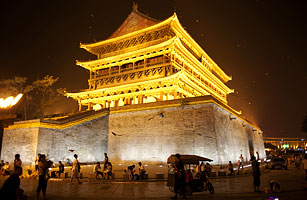
Change of tempo Major redevelopment is planned for the drum tower's vicinity
Best Place to See Before It's Gone
Beijing
In his description of 13th century Beijing, Marco Polo said he was fascinated by "a great clock — that is to say, a bell — which is struck at night. And after it is struck three times, no one must go out in the city, unless it be for the needs of a woman in labor or of the sick."
The Chinese capital has since relaxed its curfew, but the great clock remains. It is, however, a little different from what the Venetian traveler described, consisting of a drum tower and a bell tower that have stood in central Beijing for centuries. The bells no longer sound each night. That practice stopped in 1924, when the last Emperor, Pu Yi, was expelled from the Forbidden City. But the neighborhood of the towers, known to Beijingers as Gulou, retains an amiable buzz. Local bars feature rooftop drinking, folk music and pool tables. During the Lunar New Year, the open lot between the two ancient towers is engulfed by the roar of fireworks until the early morning.
That lively mix of history and community may soon give way to Beijing's relentless redevelopment. The city has budgeted $730 million over the next decade to turn Gulou into something called a Beijing Time Cultural City, complete with malls, public squares and a museum. While the old towers will stay, local preservationists fear the neighborhood will lose its shops, bars, old courtyard homes and atmosphere. They say the redevelopment of Qianmen, south of Tiananmen Square, which created a simulacrum of that neighborhood's 1920s heyday but forced out longtime residents and sanitized the area to the point of lifelessness, sets a very worrying precedent. Time, then, to visit the old Gulou, before the bell tolls for yet another part of old Beijing.
KNOW BEST: Drum Up Interest
The climb up the drum tower's unrelentingly steep steps is not for the sluggish, but it offers a panoramic view of the city's crisscrossing alleyways.